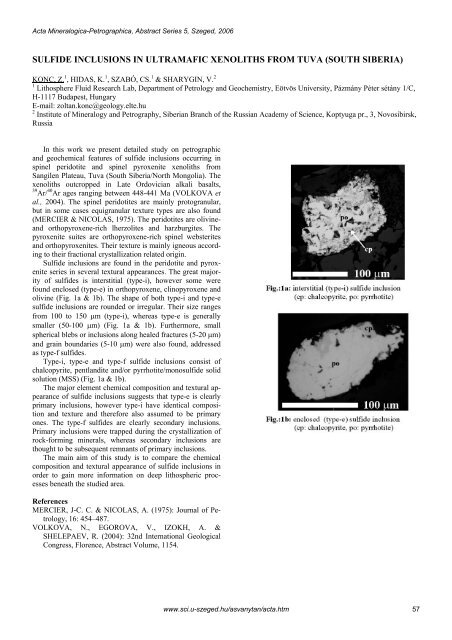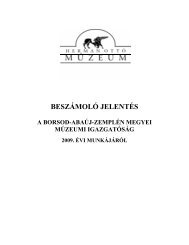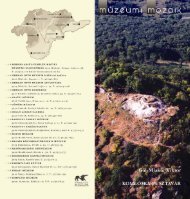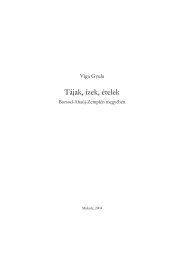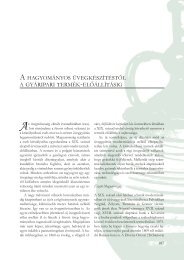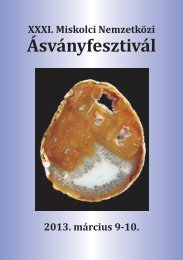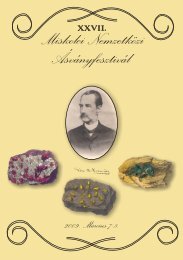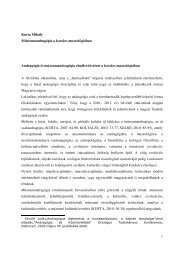Acta Mineralogica-Petrographica, Abstract Series 5, Szeged, 2006METAMORPHIC EVOLUTION OF <strong>THE</strong> EASTERN ALPSKOLLER, F. 1 , SCHUSTER, R. 2 , HOECK, V. 3 , HO<strong>IN</strong>KES, G. 4 & BOUSQUET, R. 51 Department of Geological Sciences, University of Vienna, Geozentrum, Althanstr. 14, A-1090 Vienna, AustriaE-mail: friedrich.koller@univie.ac.at2 Geological Survey, Rasumofskygasse, A-1030 Vienna, Austria3 Department of Geography, Geology and Mineralogy, University of Salzburg, Hellbrunnerstr. 34, A-5020 Salzburg, Austria4 University of Graz, 2 Universitätsplatz, A-8010 Graz, Austria5 University of Basel, 30 Bernoulli Str., CH-4036 Basel, SwitzerlandThe Eastern Alps are the product of two orogenies, a Cretaceousorogeny followed by a Cenozoic one (FROITZHEIMet al., 1996). The former is related to the closure of an embaymentof the Neotethys ocean into Apulia (Meliata Ocean),the latter is due to the closure of the Alpine Tethys oceansbetween Apulia and Europe. The result of the orogenicmovement is a complex nappe stack, which is built up fromnorth to south and from bottom to the top by the followingunits (Plate 1 in SCHMID et al., 2004): The proximal parts ofthe Jurassic to Cretaceous European margin built up thenorthern Alpine foreland and the Helvetic nappes, whereasthe distal margin is represented by the Subpenninic nappes.The Penninic nappes comprise the Piemont-Ligurian andValais Ocean (Alpine Tethys) and the Briançonnais Terrain.Apulia consists of the northern Austroalpine nappes and theSouthern Alpine unit (STAMPFLI & MOSAR, 1999). Remnantsof the Neotethys embayment occur as slices within theeastern part of the Austroalpine nappe stack. Both orogenicevents are accompanied by regional metamorphism of variableextent and P-T conditions. The Cretaceous (Eo-Alpine)metamorphism affects mainly the Austroalpine Nappes, thePenninic domain by the Cenozoic metamorphism, some unitsof the Lower Austroalpine Nappes show signs of both events.The distribution of the metamorphic facies zones in theEastern Alps is mainly controlled by the northwards transportof the Austroalpine nappes. They show a Cretaceous metamorphismand are thrusted over the Penninic domains withTertiary metamorphism. The latter are exposed in the EasternAlps only as tectonic windows.The eo-Alpine (Cretaceous) metamorphic event iswidespread within and restricted to the Austroalpine unit. It isrelated to the continental collision following the closure of anembayment of the Tethys Ocean during late Jurassic to Cretaceoustimes. Recent investigations indicate that the northernpart of the Austroalpine unit forms the tectonic lower plate.The southern parts and the north-eastern margin of theSouthalpine unit acted as the tectonic upper plate during thecontinental collision following the disappearance of the oceanicembayment (SCHMID et al., 2004). The peak of the eo-Alpine metamorphic event was reached at about 100 Ma, theyoungest cooling ages are recorded at 65 Ma (THÖNI, 1999).The eo-Alpine metamorphism starts at the base of the lowerplate with greenschist facies and increases structurally upwardsthe nappe piles until eclogite facies is reached. It decreasesagain in the uppermost nappes to sub greenschistfacies. The whole section represents a transported metamorphism.An overprint of the Variscan crystalline of the lowerplate, prior to the eo-Alpine metamorphic event, controlledby a thermal Permian event is widespread.The Tertiary Alpine metamorphic event is due to theclosure of the Jurassic to early Cenozoic Briançonnais andValais oceans (Alpine Tethys). According to WAGREICH(2001) the re-arrangement of the Penninic-Austroalpine borderzone from a passive to an active continental margin startsat about 120 Ma. From that time on the oceanic lithosphereand slices from the northern margin of the Austroalpine unit(Lower Austroalpine units) were subducted towards the southbelow (Upper) Austroalpine units. The Tertiary event reachesblueschist facies conditions in some Mesozoic parts ofPenninic windows and some units of the Lower Austroalpine(Tarntal nappe). Eclogite facies conditions followed by ablueschist event occur only in a narrow zone of the TauernWindow. The thermal peak ranges from greenschist to amphibolitefacies, the latter was only reached in the central partof the Tauern Window. After the thermal peak at about30 Ma (BLANKENBURG et al., 1989) uplift and cooling isrecorded by K-Ar and Ar-Ar ages on white micas and fissiontrack ages on zircon and apatite (GRUNDMANN &MORTEANI, 1985; FÜGENSCHUH et al., 1998). In thelower nappes of the Lower Austroalpine units the TertiaryAlpine metamorphism overprints the Cretaceous metamorphicevent.ReferencesBLANKENBURG, F. v., VILLA, I.M., BAUR, H.,MORTEANI, G. & STEIGER, R.H. (1989): Contributionsto Mineralogy and Petrology, 101: 1–11.FROITZHEIM, N., SCHMID, S.M. & FREY, M. (1996):Eclogae Geologicae Helvetiae, 89(1): 81.FÜGENSCHUH, B., SEWARD, D. & MANCKTELOW, N.(1998): Terra Nova, 9: 213–217.GRUNDMANN, G. & MORTEANI, G. (1985): Jahrbuch derGeologischen Bundesanstalt Wien, 128: 197–216.SCHMID, S.M., FÜGENSCHUH, B., KISSL<strong>IN</strong>G, E. &SCHUSTER, R. (2004): Eclogae Geologicae Helvetiae,97: 93–117.STAMPFLI, G.M. & MOSAR, J. (1999): Memorie diScienze Geologiche, 51(1): 141–154.THÖNI, M. (1999): Schweizerische Mineralogische undPetrographische Mitteilungen, 79: 209–230.WAGREICH, M. (2001): Terra Nova, 13: 401–406.56www.sci.u-szeged.hu/asvanytan/acta.htm
Acta Mineralogica-Petrographica, Abstract Series 5, Szeged, 2006SULFIDE <strong>IN</strong>CLUSIONS <strong>IN</strong> ULTRAMAFIC XENOLITHS FROM TUVA (SOUTH SIBERIA)KONC, Z. 1 , HIDAS, K. 1 , SZABÓ, CS. 1 & SHARYG<strong>IN</strong>, V. 21 Lithosphere Fluid Research Lab, Department of Petrology and Geochemistry, Eötvös University, Pázmány Péter sétány 1/C,H-1117 Budapest, HungaryE-mail: zoltan.konc@geology.elte.hu2 Institute of Mineralogy and Petrography, Siberian Branch of the Russian Academy of Science, Koptyuga pr., 3, Novosibirsk,RussiaIn this work we present detailed study on petrographicand geochemical features of sulfide inclusions occurring inspinel peridotite and spinel pyroxenite xenoliths fromSangilen Plateau, Tuva (South Siberia/North Mongolia). Thexenoliths outcropped in Late Ordovician alkali basalts,39 Ar/ 40 Ar ages ranging between 448-441 Ma (VOLKOVA etal., 2004). The spinel peridotites are mainly protogranular,but in some cases equigranular texture types are also found(MERCIER & NICOLAS, 1975). The peridotites are olivineandorthopyroxene-rich lherzolites and harzburgites. Thepyroxenite suites are orthopyroxene-rich spinel websteritesand orthopyroxenites. Their texture is mainly igneous accordingto their fractional crystallization related origin.Sulfide inclusions are found in the peridotite and pyroxeniteseries in several textural appearances. The great majorityof sulfides is interstitial (type-i), however some werefound enclosed (type-e) in orthopyroxene, clinopyroxene andolivine (Fig. 1a & 1b). The shape of both type-i and type-esulfide inclusions are rounded or irregular. Their size rangesfrom 100 to 150 µm (type-i), whereas type-e is generallysmaller (50-100 µm) (Fig. 1a & 1b). Furthermore, smallspherical blebs or inclusions along healed fractures (5-20 µm)and grain boundaries (5-10 µm) were also found, addressedas type-f sulfides.Type-i, type-e and type-f sulfide inclusions consist ofchalcopyrite, pentlandite and/or pyrrhotite/monosulfide solidsolution (MSS) (Fig. 1a & 1b).The major element chemical composition and textural appearanceof sulfide inclusions suggests that type-e is clearlyprimary inclusions, however type-i have identical compositionand texture and therefore also assumed to be primaryones. The type-f sulfides are clearly secondary inclusions.Primary inclusions were trapped during the crystallization ofrock-forming minerals, whereas secondary inclusions arethought to be subsequent remnants of primary inclusions.The main aim of this study is to compare the chemicalcomposition and textural appearance of sulfide inclusions inorder to gain more information on deep lithospheric processesbeneath the studied area.ReferencesMERCIER, J-C. C. & NICOLAS, A. (1975): Journal of Petrology,16: 454–487.VOLKOVA, N., EGOROVA, V., IZOKH, A. &SHELEPAEV, R. (2004): 32nd International GeologicalCongress, Florence, Abstract Volume, 1154.www.sci.u-szeged.hu/asvanytan/acta.htm 57
- Page 1:
MSCC33 rd MINERAL SCIENCES IN THE C
- Page 5 and 6: Acta Mineralogica-Petrographica, Ab
- Page 7 and 8: Acta Mineralogica-Petrographica, Ab
- Page 9 and 10: Acta Mineralogica-Petrographica, Ab
- Page 11 and 12: Acta Mineralogica-Petrographica, Ab
- Page 13 and 14: Acta Mineralogica-Petrographica, Ab
- Page 15 and 16: Acta Mineralogica-Petrographica, Ab
- Page 17 and 18: Acta Mineralogica-Petrographica, Ab
- Page 19 and 20: Acta Mineralogica-Petrographica, Ab
- Page 21 and 22: Acta Mineralogica-Petrographica, Ab
- Page 23 and 24: Acta Mineralogica-Petrographica, Ab
- Page 25 and 26: Acta Mineralogica-Petrographica, Ab
- Page 27 and 28: Acta Mineralogica-Petrographica, Ab
- Page 29 and 30: Acta Mineralogica-Petrographica, Ab
- Page 31 and 32: Acta Mineralogica-Petrographica, Ab
- Page 33 and 34: Acta Mineralogica-Petrographica, Ab
- Page 35 and 36: Acta Mineralogica-Petrographica, Ab
- Page 37 and 38: Acta Mineralogica-Petrographica, Ab
- Page 39 and 40: Acta Mineralogica-Petrographica, Ab
- Page 41 and 42: Acta Mineralogica-Petrographica, Ab
- Page 43 and 44: Acta Mineralogica-Petrographica, Ab
- Page 45 and 46: Acta Mineralogica-Petrographica, Ab
- Page 47 and 48: Acta Mineralogica-Petrographica, Ab
- Page 49 and 50: Acta Mineralogica-Petrographica, Ab
- Page 51 and 52: Acta Mineralogica-Petrographica, Ab
- Page 53 and 54: Acta Mineralogica-Petrographica, Ab
- Page 55: Acta Mineralogica-Petrographica, Ab
- Page 59 and 60: Acta Mineralogica-Petrographica, Ab
- Page 61 and 62: Acta Mineralogica-Petrographica, Ab
- Page 63 and 64: Acta Mineralogica-Petrographica, Ab
- Page 65 and 66: Acta Mineralogica-Petrographica, Ab
- Page 67 and 68: Acta Mineralogica-Petrographica, Ab
- Page 69 and 70: Acta Mineralogica-Petrographica, Ab
- Page 71 and 72: Acta Mineralogica-Petrographica, Ab
- Page 73 and 74: Acta Mineralogica-Petrographica, Ab
- Page 75 and 76: Acta Mineralogica-Petrographica, Ab
- Page 77 and 78: Acta Mineralogica-Petrographica, Ab
- Page 79 and 80: Acta Mineralogica-Petrographica, Ab
- Page 81 and 82: Acta Mineralogica-Petrographica, Ab
- Page 83 and 84: Acta Mineralogica-Petrographica, Ab
- Page 85 and 86: Acta Mineralogica-Petrographica, Ab
- Page 87 and 88: Acta Mineralogica-Petrographica, Ab
- Page 89 and 90: Acta Mineralogica-Petrographica, Ab
- Page 91 and 92: Acta Mineralogica-Petrographica, Ab
- Page 93 and 94: Acta Mineralogica-Petrographica, Ab
- Page 95 and 96: Acta Mineralogica-Petrographica, Ab
- Page 97 and 98: Acta Mineralogica-Petrographica, Ab
- Page 99 and 100: Acta Mineralogica-Petrographica, Ab
- Page 101 and 102: Acta Mineralogica-Petrographica, Ab
- Page 103 and 104: Acta Mineralogica-Petrographica, Ab
- Page 105 and 106: Acta Mineralogica-Petrographica, Ab
- Page 107 and 108:
Acta Mineralogica-Petrographica, Ab
- Page 109 and 110:
Acta Mineralogica-Petrographica, Ab
- Page 111 and 112:
Acta Mineralogica-Petrographica, Ab
- Page 113 and 114:
Acta Mineralogica-Petrographica, Ab
- Page 115 and 116:
Acta Mineralogica-Petrographica, Ab
- Page 117 and 118:
Acta Mineralogica-Petrographica, Ab
- Page 119 and 120:
Acta Mineralogica-Petrographica, Ab
- Page 121 and 122:
Acta Mineralogica-Petrographica, Ab
- Page 123 and 124:
Acta Mineralogica-Petrographica, Ab
- Page 125 and 126:
Acta Mineralogica-Petrographica, Ab
- Page 127 and 128:
Acta Mineralogica-Petrographica, Ab
- Page 129 and 130:
Acta Mineralogica-Petrographica, Ab
- Page 131 and 132:
Acta Mineralogica-Petrographica, Ab
- Page 133 and 134:
Acta Mineralogica-Petrographica, Ab


